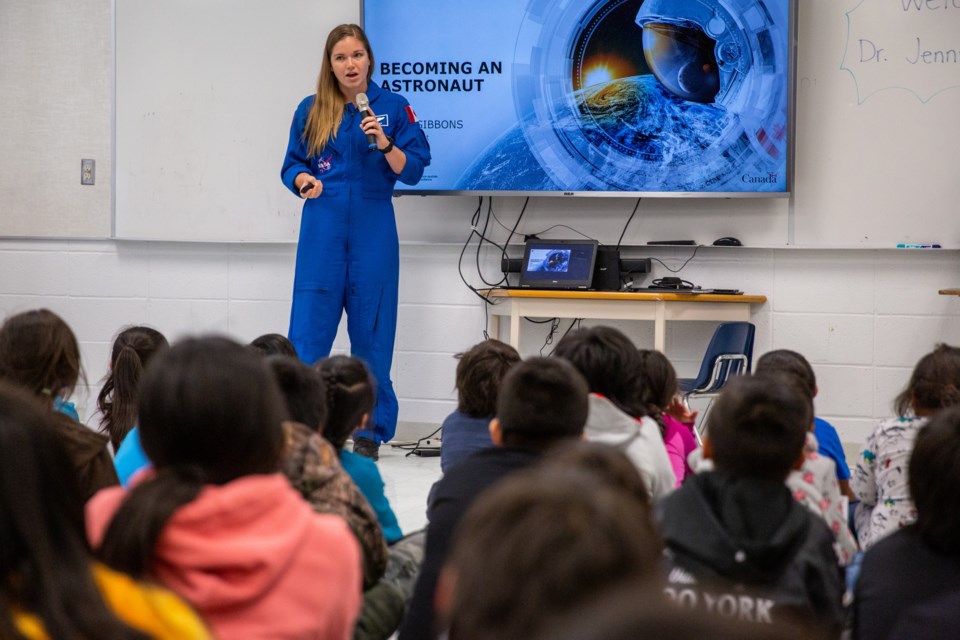EXSHAW – Exshaw School students got a chance to blast off to space last week and understand what life is like to train as a Canadian astronaut.
Jenni Sidey-Gibbons, a Canadian Space Agency (CSA) astronaut, spoke with students about the ins and outs of travelling to space, as well as provide details about a new junior astronaut program.
Sidey-Gibbons began the (Nov. 1) event by talking a bit about what she does and how she got to where she is. Based in Houston, Texas, she told the Outlook coming to Canadian classrooms is definitely a job perk.
“I love it, I feel like it’s one of the nicest parts of my job, because I live in Houston and I feel a bit disconnected from the people that I’m working for, which is Canada,” she said.
“Speaking to kids is the most fun because they have the most honest questions, they’re the most engaged, they’re fascinated by space, and they’re all explorers.”
The questions, of course, did not disappoint.
“Have you met any aliens?” one student asked from the sea of cross-legged children.
“How do you go the bathroom in space?” asked another.
“Can you shower?” “How do you sleep?” “Do you miss your family?”
Sidey-Gibbons answered them all with grace, even though she hasn’t yet been to space herself, and the students were a little disappointed she’d never come face-to-face with an alien.
“How do you sleep? Oh, I love this question, this is such a good question,” Sidey-Gibbons said.
“You know when you go to bed here on Earth, you lie in your bed, you’d have your pillow with you. You don’t really do that in space because you can’t lie down – there’s no gravity that pulls you down. So you’re sort of floating there, you have like a sleeping bag, kind of like if you were to go camping.
"You sort of tuck yourself up in it and then you tether yourself to a wall … You just float there – you have to get used to just floating.”
She said some people really struggle to sleep in space as a result, though some don’t mind it at all. As for using the washroom, Sidey-Gibbons said there’s a vacuum like toilet that sucks in the bodys waste. As well, there’s no showering in space. Essentially an astronaut would do the equivalent of a sponge bath. Sidey-Gibbons explained that water in space sort of floats, so along with no shower, there’s no laundry in space – astronauts wear their clothes until they are at their stinkiest.
Layla Okeeweehow, Grade 6, said she loved the presentation because she herself is interested in space.
“I want to try my best to be an astronaut when I grow up,” she said.
“My favourite part is when I learned about if astronauts can breathe … I didn’t know that they couldn’t shower. I feel weird because sometimes they’ll be stinky.”
Okeeweehow said despite the possibility of being stinky, she absolutely still wants to go to space.
For Rashaun Powderface, Grade 7, becoming an astronaut became a little more tangible when Sidey-Gibbons indicated science is a big part of it.
“I liked how science-y it was,” he said, adding he’s a big fan of the subject.
The CSA requires a long process and a lot of training before one can actually go to space. Calgary-born Sidey-Gibbons said she is only about two years into what could be a 10-year process. So far, she said she has been surprised at how vast the work the Canadian Space Agency does.
“I think the most surprising thing would be getting a really inside view of what the team is like that sends people into space,” she told the Outlook in an interview.
“I think I knew that it was this huge machine of people that enabled space flight and exploration, but I don’t think I had any idea really of the scale of it. The Canadian Space Agency and the number of people they put forward to support missions – it’s not just human space flight – satellite development, Earth observation. Space just enables so much of life on Earth and I don’t think I really had a concept of just how important that was until I entered the space program.”
Topping off her presentation, Sidey-Gibbons encouraged students interested in space to get involved.
“There is a program that the Canadian Space Agency just started called Junior Astronauts,” Sidey-Gibbons told the students.
“You guys are the perfect age to get involved in Junior Astronauts. We are looking for people like you to be involved in different activities – which are all online; your teachers can find them – in three main areas, the areas that are most important for becoming an astronaut. Science and technology … fitness and nutrition … and teamwork and communication.”
Sidey-Gibbons said students can win a visit from an astronaut or students from Grades 6-9 can win a week with the Canadian Space Agency training with astronauts and space experts.
Visit http://asc-csa.gc.ca/eng/resources-young/junior-astronauts/default.asp for more information on the Junior Astronauts program.




